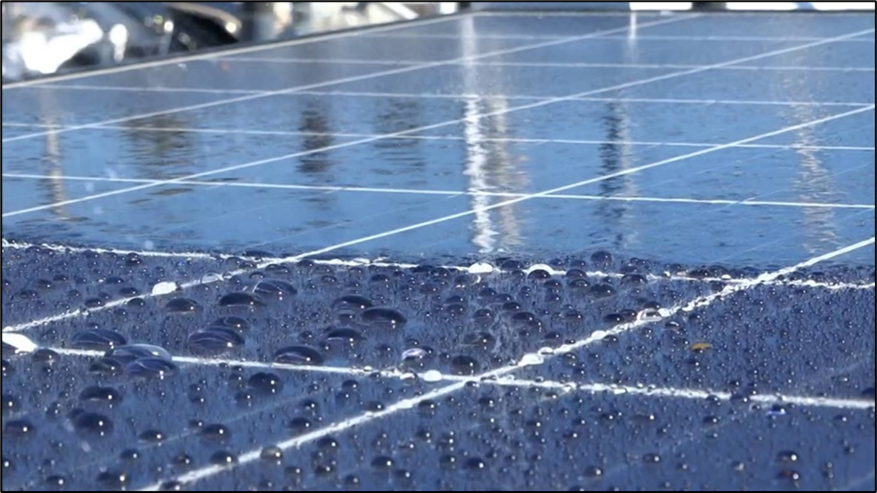
As the need for renewable energy and sustainable practices increases every year, so does the need for more efficient and effective maintenance strategies of these technologies. In the solar industry, the solar panels are required to be free from dust, debris and other pollutants that could affect the performance and overall efficiency of the panels to generate electricity. This has led NrG to explore and pilot a nano-coating technology on a solar plant, with the aim to protect the solar panels without impacting their effectiveness and reducing the maintenance required.
1. Hydrophobic
The research led us to understand more about the many advantageous properties that nano-coatings can display, such as being hydro- and oleo-phobic as well as hydrophilic. This means that the coating repels water and oils and provides an anti-stick surface. This is beneficial as it allows for the solar panels to dry quicker and guarantees that less water is needed to clean and maintain the panels. In addition, this characteristic ensures that the panels remain cleaner for longer as the liquid droplets will carry away pollutants, this is often referred to as the self-cleaning property[1]. An example of the hydrophobic water droplets can be seen in Figure 1 below.

Figure 1: An example of hydrophobic properties[2]
2. Anti-reflective
Furthermore, nano-coatings can have anti-reflective features, meaning that they are more effective in absorbing light[3]. This is useful as it reduces the reflection of light and enables better solar panel efficiency in low-lighting conditions. Thus, allowing for more energy generation during early mornings and late evenings.
3. Repel Micro-organisms
The growth of micro-organisms such as moss, mould, and lichen can also be avoided through nano-coatings[4], which can prove favourable in places where there is high humidity and rainfall, further protecting the solar panels from extra damage. An example of moss growth can be seen in Figure 2 below.

Figure 2: Example of moss growth on a solar panel[5]
4. Physical protection
Not only can nano-coatings exhibit all these properties, but it also acts as an extra physical layer of protection from etching, scratches, and surface degradation[6]. This is beneficial in extending the useful life of the solar panels and ensuring less damage from the external environment.
5. Improved efficiencies and O&M cost
Studies have also shown that nano-coatings have helped to improve solar panel effectiveness and overall output power generation[7]. In addition, they have shown to decrease maintenance costs and reduce cleaning cycles[8].
6. Pilot Project
In April this year, NrG undertook a nano-coating pilot project at a customer’s site using 200 solar panels, where 100 panels were coated with a nanomaterial. The remaining 100 panels were left uncoated as a baseline to evaluate against. NrG’s goal was to investigate whether these above-mentioned beneficial properties of the nano-coating technology can be utilised to have longer-lasting and more efficient solar plants. This pilot project will run for a year, after which NrG can justify the impact and performance of nano-coating and give recommendations for future solar sites. Figure 3 below, shows NrG’s freshly coated panels in a late afternoon sun.

Figure 3: NrG’s freshly coated panels in a late afternoon sun
[1] https://solartechadvisor.com/solar-panel-nano-coatings/
[2]https://www.google.com/search?q=hydrophilic+solar+panel&tbm=isch&ved=2ahUKEwjMjPT89dL3AhUS8hoKHURWC9cQ2-cCegQIABAA&oq=hydrophilic+solar+panel&gs_lcp=CgNpbWcQAzoFCAAQgAQ6BggAEAgQHjoECAAQGDoECAAQHlCVC1izGmCKHmgAcAB4AIABuQOIAfwikgEHMi00LjUuNJgBAKABAaoBC2d3cy
[3] https://www.coating.com.au/solar-panel-coating-australia/
[4] http://blog.thesolarlabs.com/2020/11/05/nanotechnology-in-solar-energy/
[5] https://mossrooftreatment.com.au/roof-cleaning/solar-panels
[6] https://www.milkthesun.com/en/services/nanocoating
[7]Aljdaeh, E. et al., 2021. Performance Enhancement of Self-Cleaning Hydrophobic Nanocoated Photovoltaic Panels in a Dusty Environment. Energies, 14(20)
[8] Yadav, V. & Mishra, A., 2013. Role of Nanocoating in Maintaining Solar PV Efficiency: An Overview. International Journal of Applied Science and Technology, pp. 21-28.

